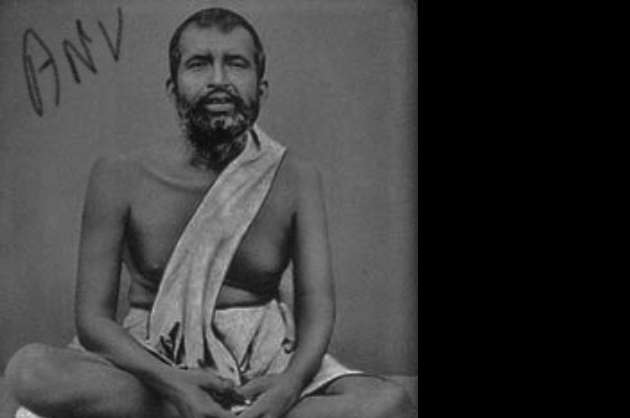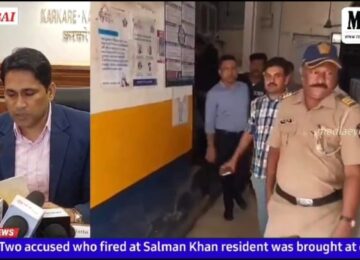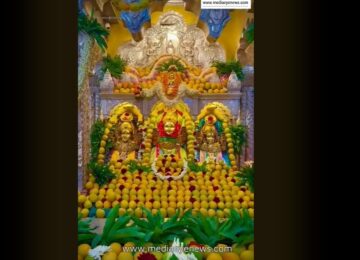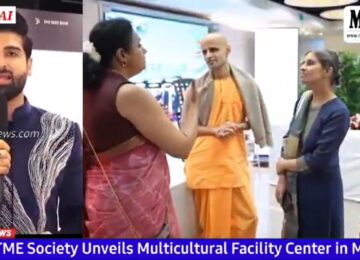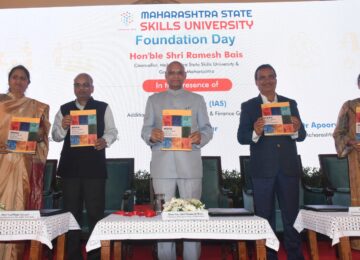Anupama Nair
The story of Ramakrishna Paramahamsa is a story of religion in practice. His life embraces us to see God face to face. We cannot read the story of his life without being convinced that God alone is real and the rest is illusion. He was the living embodiment of Godliness, and his sayings are not those of a learned man, but they are the pages from the book of his life. They are revelations of his own experiences. In today’s world of skepticism, he is a living example of bright and living faith, which gives solace to us, in this troubled times if we bother to read his books. Ramakrishna’s life was a lesson in Ahimsa or non-violence. His love encompassed all and knew no limits.
He is the Guru of Swami Vivekanand. He is responsible for converting Narendra Dutta to Swami Vivekananda. Swamiji is one of the persons who has inspired me in every aspect of my life. Just reading his book “My India, Eternal India” on a train journey changed my views of my great Bharat Maa. In the words of a disciple of Swamiji Sister Christine “Our love for India came to birth, I think, when we first heard him (Swami Vivekananda) say the word, "India", in that marvelous voice of his. It seems incredible that so much could have been put into one small word of five letters. It seems incredible that so much could have been put into one small word of five letters. There was love, passion, pride, longing, adoration, tragedy, chivalry, and again love. Whole volumes could not have produced such a feeling in others. It had the magic power of creating love in those who heard it.” The result was me–, a big fan of the Western life and philosophy began to look towards my own country of birth.
I came to know about Sri Ramakrishna as my family for years were associated with the Ramakrishna Mission and a visit to the Mission was frequent in childhood. When I grew up, I worked as a teacher for the Rama Krishna Mission, Jamshedpur. That was the first time I saw a school, where children who could not afford to pay the school fees were not penalized. The education provided to the children was of highest quality. From Jamshedpur, I had the good fortune to visit Dakshineshwar and the Belur Mutt.
He was born as born Gadadhar Chattopadhyaya in February 1836 in the village of Kamarpukur in the Hoogly district of the Indian state of Bengal, into a very poor, pious, and orthodox Brahmin family. Kamarpukur was undamaged by the glamour of a city and contained paddy fields, tall palms trees, royal banyans, a few lakes etc., unlike Calcutta. His parents were Khudiram Chattopadhyay and Chandramani Devi. It is believed that Sri Ramakrishna's parents experienced supernatural incidents and visions before his birth. In Gaya, his father Khudiram had a dream in which Lord Vishnu or Gadadhara appeared and said that he would be born as his son. Chandramani Devi had a vision of light entering her womb from a Shiva temple. The family was devoted to Hindu Lord Rama, and all their male children were given names –Ramkumar, Rameshwar, and Ramakrishna.
He rejected the traditional method of schooling, but was well versed in Ramayana, Mahabharata, Puranas etc. He however, was a talented boy, and could sing and paint well. He was fond of serving holy men and listening to their discourses. He was often found to be absorbed in spirituality. At the age of six, he experienced the “first ecstasy” while watching a flight of white cranes moving against the background of black clouds near a paddy field. This tendency to enter into ecstasy intensified with age. His father’s death when he was only seven years old, served to deepen his introspection and increase his detachment from the samsara or the world.
When Sri Ramakrishna was sixteen, his elder brother Ramkumar took him to Calcutta to assist him in his priestly duties. In 1855, the Kali Temple at Dakshineswar was built by Rani Rasmani (a rich zamindarin) , was sanctified and Ramkumar became the chief priest there. When he died a few months later, Ramakrishna was appointed as the priest. Ramakrishna developed intense devotion to Mother Kali and spent hours in loving adoration, forgetting the rituals of the temple and his priestly duties. His intense longing concluded into the vision of Mother Kali as boundless effulgence engulfing everything around him.
To the world who has seen many intoxication – alcohol, power, money, god-intoxicated state was new. This state alarmed his relatives in Kamarpukur and they got him married to Sarada, a girl from the neighboring village of Jayrambati. After his marriage, Sri Ramakrishna plunged into even more intense spiritual practices and impelled by a strong inner urge to experience the different aspects of God he was helped by a series of Gurus who taught him the various paths described in the Hindu scriptures, and he realized God through each one of them. His first guru in 1861 was a remarkable woman known as Bhairavi Brahmani who was well versed in scriptures. With her help Sri Ramakrishna practiced various difficult disciplines of the Tantrik path, and attained success in all of them. Three years later came a wandering monk by name Totapuri, under whose guidance Sri Ramakrishna attained Nirvikalpa Samadhi, the highest spiritual experience mentioned in the Hindu scriptures. He remained in that state of non-dual existence for six months without the least awareness of even his own body. In this way, Sri Ramakrishna relived the entire range of spiritual experiences of more than three thousand years of Hindu religion within a few years. Remarkable isn’t it!
With his voracious thirst for God, Sri Ramakrishna broke the frontiers of Hinduism, he glided through the paths of Islam and Christianity, and attained the highest realization through each one of them in a short span of time. He looked upon Jesus and Buddha as incarnations of God, and venerated the ten Sikh Gurus. He expressed the quintessence of his twelve-year-long spiritual realizations in a simple belief “Yato mat, tato path (As many faiths, so many paths)”. He now habitually lived in an exalted state of consciousness in which he saw God in all beings.
In 1872, Sarada, who was now nineteen years old, came from the village to meet him. He received her cordially, and taught her how to attend the household duties and at the same time lead a spiritual life. It is said, one night he worshipped her as the Divine Mother in his room at the Dakshineswar temple. Although, Sarada continued to stay with him, they lived pure lives, and their marital relationship was only spiritual. They never lived like a married couple. It should be mentioned here that Sri Ramakrishna had been ordained a Sannyasi, and he observed the basic vows of a monk to perfection. But outwardly he lived like any lay man — humble, loving and with childlike simplicity. During Sri Ramakrishna’s stay at Dakshineswar, Rani Rasmani acted as his patron and after her death, her son-in-law Mathur Nath Biswas took care of his needs.
Sri Ramakrishna’s name began to spread across the country. Mathur (son-in-law) of Rani Rasmani) convened an assembly of scholars, and they declared him to be the Avatar of the Modern Age. In those days, the socio-religious movement known as Brahmo Samaj (founded by Raja Ram Mohan Roy), was very popular in Bengal. Brahmo Samaj was formed to reform the Hindu religion. His teaching on harmony of religions attracted many people belonging to different communities, and Dakshineswar became a “Parliament of Religions”.
In 1875, Sri Ramakrishna met the influential leader of Brahmo Samaj Keshab Chandra Sen. Keshab had accepted Christianity, and had separated from the Adi Brahmo Samaj. Keshab had rejected idolatry, but under the influence of Ramakrishna he accepted Hindu polytheism and established the "New Dispensation" or “Nava Vidhan”, based on Ramakrishna's principles of "Worship of God as Mother", "All religions are true" and "Assimilation of Hindu polytheism into Brahmoism". Sen published Ramakrishna's teachings in the journals of New Dispensation over a period of several years, that was instrumental in bringing Ramakrishna to the attention of a wider audience, especially the Bhadralok (English-educated classes of Bengal) and the Europeans residing in India.
Many of the prominent people of Calcutta, Pratap Chandra Mazumdar, Shivanath Shastri and Trailokyanath Sanyal visited him in the period from 1871–1885. Mazumdar was the author of the first English biography of Ramakrishna, “The Hindu Saint” in the “Theistic Quarterly Review (1879), that played a vital role in introducing Ramakrishna to Europeans like the German Indologist (study of India) Max Mueller. Newspapers of that time reported that Ramakrishna was spreading "Love" and "Devotion" among the educated classes of Bengal and that he had succeeded in reforming many youths with corrupt morals. Sri Ramakrishna also had interactions with Debendranath Tagore (father of Rabindranath Tagore), and the great Ishwar Chandra Vidyasagar, who was a renowned social worker. He had also met the founder of Arya Samaj, Dayanda Saraswati. Sri Ramakrishna was considered one of the main contributors to the Renaissance in India,
Then happened a chance meeting with a young student Narendranath Dutta, who was an atheist that changed the course of Indian history and world’s concept of India. Among the Europeans who were influenced by Sri Ramakrishna was the Principal of the Scottish Church College, Calcutta Mr. William Hastie. While explaining the word trance in the poem “The Excursion” by William Wordsworth, Hastie told his students that if they wanted to know its "real meaning", they should go to "Ramakrishna of Dakshineswar." This prompted some of his students, including Naren to visit Ramakrishna.
It is said he asked several prominent Calcutta residents if they had come "face- to-face with God", but none of their answers gave him satisfaction. At this time, Narendra met Debendranath Tagore, and asked if he had seen God. Instead of answering his question, Tagore said "My boy, you have a Yogi’s eyes." According to Banhatti, a historian it was Sri Ramakrishna who really answered Narendra's question, by saying "Yes, I see Him as I see you, only in an infinitely intense sense." It was also due to Sen that he met his Guru and idol Sri Ramakrishna in 1881.
In late 1881 or early 1882, Narendra went to Dakshineswar with two friends and met Sri Ramakrishna. This meeting proved to be a turning point in the life of Naren. Although, he did not initially accept Ramakrishna as his teacher and rebelled against his ideas, he was attracted by his personality and began to frequently visit him at Dakshineswar. He initially saw Sri Ramakrishna's ecstasies and visions as "mere figments of imagination" and "hallucinations". As a member of Brahmo Samaj, he opposed idol worship, polytheism and Ramakrishna's worship of Devi Kali. He even rejected the Advaita Vedanta of "identity with the absolute", and often ridiculed the idea. Narendra even tested Sri Ramakrishna, who faced his arguments patiently, "Try to see the truth from all angles", he replied to his shishya
Narendra's father's sudden death in 1884 left the family bankrupt, creditors began demanding the repayment of loans, and relatives threatened to evict the family from their ancestral home. Narendra, once a son of a well-to-do family, became one of the poorest students in his college. He unsuccessfully tried to find work and became an atheist. He found solace in Sri Ramakrishna and his visits to Dakshineswar became more frequent
One day, Narendra requested Sri Ramakrishna to pray to Devi Kali for their family's financial welfare. Ramakrishna advised him to go to the temple himself and pray. Following Sri Ramakrishna's suggestion, he went to the temple thrice, but failed to pray for any kind of worldly necessities and ultimately prayed for true knowledge and devotion from the Devi. Narendra gradually grew ready to renounce everything for the sake of God realization, and accepted Sri Ramakrishna as his Guru.
Sri Ramakrishna did not write any book, nor did he deliver public speeches. Instead, he chose to speak in a simple language using parables and metaphors by way of illustration, drawn from the observation of nature and ordinary things of daily life. His conversations were charming and attracted the cultural elite of Bengal. These conversations were noted down by his disciple Mahendranath Gupta who published them in the form of a book, “Sri Ramakrishna Kathamrita” in Bengali and “The Gospel of Sri Ramakrishna” in English, and these books are popular even today.
In the beginning of 1885, Sri Ramakrishna suffered from clergyman's throat, which gradually developed into throat cancer. The best medical treatment available at that time was provided to him, but his condition aggravated and he left his mortal body on 16 August 1886 in Cossipore. Narendra decided to convert a dilapidated house at Baranagar into a new matt for the remaining disciples. Rent for the Baranagar Matt was low, raised by "holy begging". The matt became the first building of the Ramakrishna Matt, the monastery of the monastic order of Sri Ramakrishna. Narendra and other disciples used to spend many hours in practicing meditation, and religious austerities every day.
On the Christmas Eve of 1886, Narendra and eight other disciples took formal monastic vows. They decided to live their lives as their master Sri Ramakrishna lived. In 1888, Narendra left the monastery as a Parivrâjaka— the Hindu religious life of a wandering monk, "without fixed abode, without ties, independent and strangers wherever they go". His sole possessions were a kamandalu (water pot), staff and his two favorite books: The Bhagvad Gita and the Imitation of Christ written by Thomas Kempis. Narendra travelled extensively in India for five years, visiting centers of learning and familiarizing himself with diverse religious traditions and social patterns. He developed sympathy for the suffering and poverty of the people, and resolved to uplift the nation. Living primarily on bhiksha (alms), Narendra travelled on foot and by railway (with tickets bought by admirers). During his travels he met, and stayed with Indians from all religions and walks of life –scholars, dewans, rajas and government officials. He adopted the name Vivekananda.
The Parliament of the World's Religions was inaugurated on 11 September, 1893 at the Art Institute of Chicago, in Chicago, as part of the World’s Columbian Exposition. On this day, Vivekananda gave a brief speech representing India and Hinduism. Though he was initially nervous, he bowed to Saraswati Devi (the Hindu goddess of learning) and began confidently with "Sisters and brothers of America!". At these words, Vivekananda received a two-minute standing ovation from the crowd of seven thousand. According to Sailendra Nath Dhar, when silence was restored, he began his address, “greeting the youngest of the nations on behalf of the most ancient order of monks in the world, the Vedic order of sannyasis, a religion which has taught the world both tolerance and universal acceptance”. Though, "it was only a short speech, but it voiced the spirit of the Parliament of Religions."
John Henry Barrows, the President of the Parliament, hailed "India, the Mother of religions was represented by Swami Vivekananda, the Orange-monk who exercised the most wonderful influence over his auditors". Vivekananda attracted widespread attention in the press, which called him the "cyclonic monk from India". The New York Critique reported, "He is an orator by divine right, and his strong, intelligent face in its picturesque setting of yellow and orange was hardly less interesting than those earnest words, and the rich, rhythmical utterance he gave them". According to American newspapers Vivekananda was "the greatest figure in the Parliament of religions" and "the most popular and influential man in the Parliament". The Boston Evening Transcript stated that Vivekananda was "a great favorite at the Parliament, if he merely crosses the platform, he is applauded". He spoke several more times "at receptions, the scientific section, and private homes", topics related to Hinduism, and harmony among religions until the Parliament ended on 27 September 1893. He soon became known as a "handsome oriental" and made a huge impression as an orator.
After the Parliament of Religions, he toured many parts of the US as a guest. His popularity opened up new views for expanding on "life and religion to thousands". During a question-answer session at Brooklyn Ethical Society, New York, he stated, "I have a message to the West as Buddha had a message to the East."
Vivekananda spent nearly two years lecturing in the eastern and central United States, primarily in Chicago, Detroit, Boston and New York. He started the Vedanta Society of New York in 1894. During his visit to the West, he visited England twice, in 1895 and 1896, lecturing successfully there. During his second visit to the UK in May 1896 Vivekananda met Max Mueller, who was a noted Indologist, who wrote Ramakrishna's first biography in the West. From the UK, Vivekananda visited other European countries. Vivekananda was offered academic positions in two American universities (Eastern Philosophy at Harvard University and University of Columbia). However, he declined both, since his duties would conflict with his commitment as a monk.
He initiated several followers — Marie Louise who became Sister Abhayanda and Leon Landsberg became Swami Kripananda, so that they could continue the work of the mission of the Vedanta Society. This society still has foreign nationals and is also located in Los Angeles, California. During his stay in America, Vivekananda was given land in the mountains to the southeast of San Jose, California, to establish a retreat for Vedanta students. He called it "Peace retreat, or Shanti Ashrama. The largest American center is the Vedanta Society of Southern California in Hollywood. There is also a Vedanta Press in Hollywood which publishes books about Vedanta and English translations of Hindu scriptures and texts.
Vivekananda founded the The Ramakrishna Mission in 1897 for social service. Its ideals are based on Karma Yoga and its governing body consists of the trustees of both Ramakrishna Matt and Ramakrishna Mission and have their headquarters at Belur Matt, Calcutta. Vivekananda founded two other monasteries: one in Mayavati in the Himalayas (near Almora), the Advaita Ashram. Two journals were founded—Prabudha Bharatam in English and Udbhodan in Bengali. However, the greatest of Swamiji’s disciple of Margaret Noble who was named as Sister Nivedita, and she lived for many years following her Guru’s ideals. She died in India, and was buried here,
Vivekananda had earlier inspired Jamshed ji Tata (founder of Tata Sons) to set up a research and educational institution when they travelled together from Yokohoma to Chicago on Swamij’s first visit to the West in 1893. Tata, asked him to head his Research Institute of Science. Vivekananda declined the offer, citing a conflict with his "spiritual interests". After brief visits to Lahore, Delhi and Khetri, he returned to Calcutta in January 1898. He consolidated the work of the matt and trained disciples for several months.
On 4 July 1902, Vivekananda awoke early, went to the monastery at Belur Matt and meditated for three hours. He discussed with his colleagues and planned to establish a Vedic college in the Ramakrishna Matt. At 7:00 pm Vivekananda went to his room, asking not to be disturbed. He died at 9:20 p.m. while doing meditation. According to his disciples, Vivekananda attained “maha-samadhi”. The rupture of a blood vessel in his brain was reported as a possible cause of death. Vivekananda prophecy that he would not live forty years came true. He was cremated on bank of the Ganga in Belur Matt, opposite where his Guru, Sri Ramakrishna was cremated sixteen years ago.
Charles Freer Andrews a social reformer stated, "The Swami's intrepid patriotism gave a new color to the national movement throughout India. More than any other single individual of that period Vivekananda had made his contribution to the new awakening of India". His nationalistic ideas influenced many other Indian thinkers and leaders, like Sri Aurobindo who regarded Vivekananda as the one who awakened India spiritually.
Quotes of Sri Ramakrishna
“You see many stars in the sky at night, but not when the sun rises. Can you therefore say that there are no stars in the heaven during the day? O man, because you cannot find God in the days of your ignorance, say not, there is no God.”
“He is born in vain, who having attained the human birth so difficult to get, does not attempt to realize God in this very life.”
“There are pearls in the deep sea, but you must hazard all perils to get them, if you fail to get them by single dive, do not make conclusion that the sea is without them. Dive again and again, and you are sure to be rewarded in the end”.
“God is the infinite being, while the Jiva is only a finite being. How then, can the finite grasp the infinite? It is like a doll made of salt trying to fathom the depth of the ocean”.
These are very valid quotes for today’s life. I can only hope every one is inspired by the Master and his disciple Vivekananda. At the outset, it was Sri Ramakrishna, Sarada Devi and Swamiji who inspired me to write this article. I am only an instrument and it was Mother Kali who came as thoughts in my mind, which got converted into words.
(Dedicated to Ramakrishna Mission –Trivandrum, Vivekananda Ashram – Kanyakumari, Ramakrishna Mission School – Jamshedpur, and Belur Matt – Calcutta. Picture courtesy: Ramakrishna Mission School, Jamshedpur)

